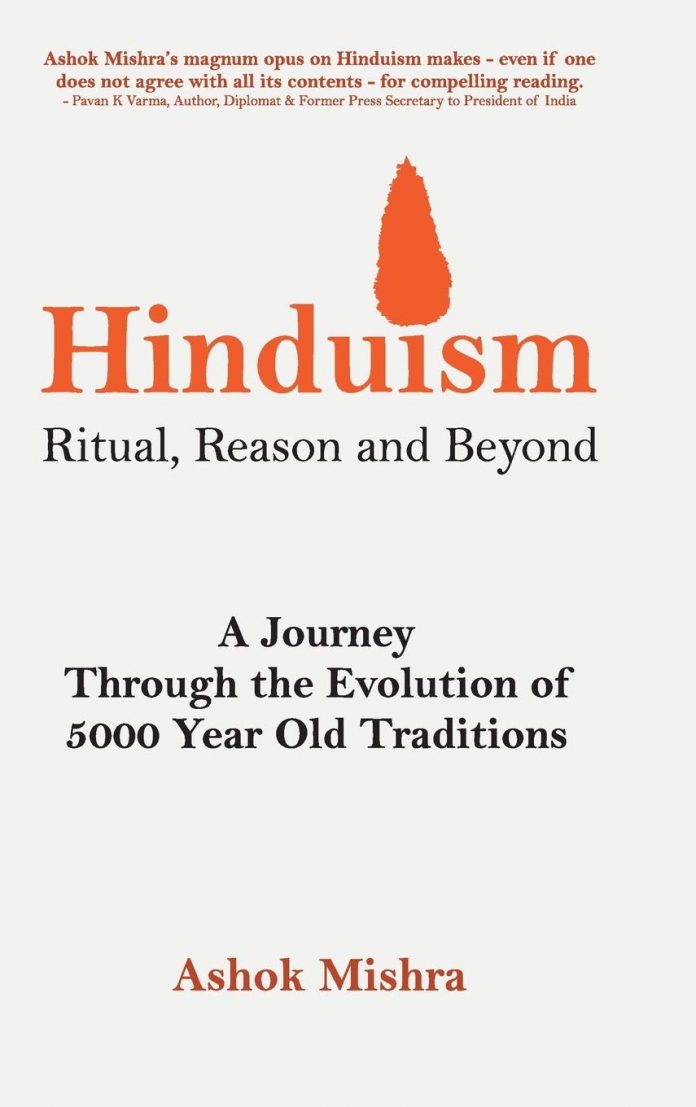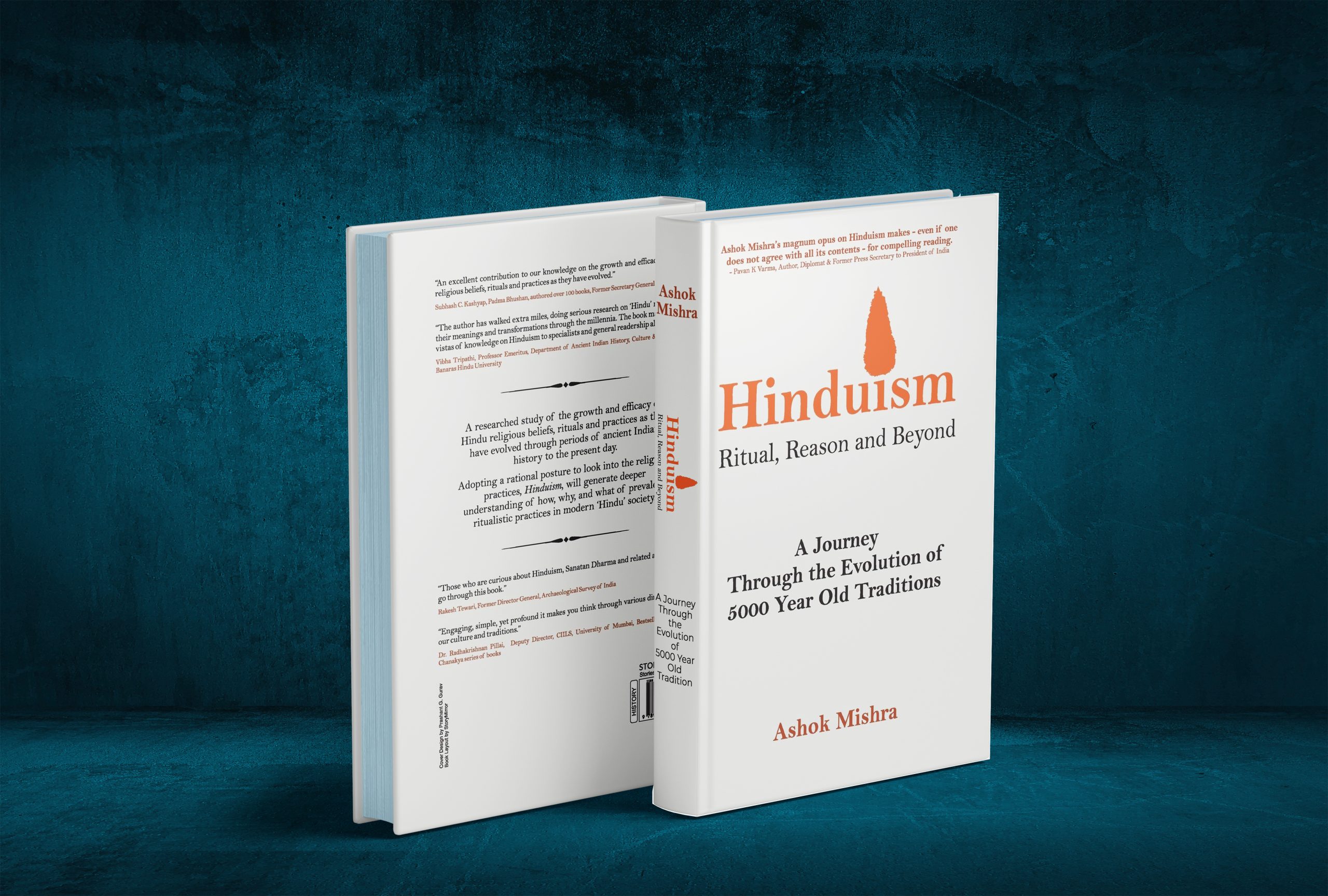Title: Hinduism: Ritual, Reason and Beyond
Author: Ashok Mishra
Publisher: StoryMirror Infotech Pvt Ltd
Genre: Hinduism, Indian History, Religion History
First Publication: 2019
Language: English
Book Summary: Hinduism- Ritual, Reason and Beyond by Ashok Mishra
The book is journey through 5000 years of evolution of Hinduism, and is outcome of seven years of study to understand the roots of Hinduism. Tracing the genesis of Hinduism to pre-Indus Valley period, the book explains Hindu, Hinduism and Sanatana Dharma, before it takes one through Hinduism’s oldest scriptures – the four Vedas, the four components of each Veda, and what they contain. How all original translations of Vedic texts were done by Western Sanskrit scholars, and why their works have left scope for doubt about the fidelity of translations.
The yajnas (yagya) like Ashvamedha, Rajsooya, Vajpeya, etc., about which we only hear on TV serials and talk shows, have been demystified. The reader will be taken aback reading the sheer size and scale of Soma yajna, described step by step, in great detail. Hinduism’s journey to the Age of Reason, the Upanishads, its encounter with Buddhism, and its transformation into idol worshipping society with many gods and a multitude of stories about its millions of gods is lucidly explained. Puranas, what they contain and what was the reason they were created, has been described and explained next.
Hinduism’s journey to its modern form – idol worship, the modern puja, detailed description of puja and Sanskaras like Vivaha, their detailed description, the meaning of each action and how they are conducted, the gift to the priest, types of idols, their consecration, all are explained to help a reader understand the why and the how of what we do as a Hindu.
The book concludes with a discussion of – Do mantras have power? & Do rituals have meaning?
Book Review- Hinduism: Ritual, Reason and Beyond by Ashok Mishra
‘Hinduism’ by Ashok Mishra is an overview of almost 5000 years of Hinduism expressed in the range of 6 parts and 41 chapters. Beginning with arrival of Aryans to Indus civilization, charting across the Vedic culture and its influence on successive religious movements. The chapters on Sanatana Dharma, Vedas, Yajnas, Hindu scriptures, rituals and social hierarchy is dealt in concise ways inviting further explorations. Concerns of Mantras, Hindu ritual and Hinduism in modern context closes the text. It’s a detailed introduction with more of anthropological, sociological approach to the religion.
The book was well written and author does a very fine job of covering 5000 years of evolution of Hinduism. It was worth the time and left me with a better 30,000 foot understanding of Hinduism. One need to spend more time reading the Vedas, the Upanishads, the Epics, and the Sutras to have understanding of Hinduism like the author Ashok Mishra has. This book takes a scholarly approach to explain some of key foundations of Hinduism and it’s relation to Indian society and the world. I think this has helped me a lot in understanding parts of the foundation and influence of Hinduism and Sanatana Dharma.
It summarizes Hinduism and the Hindus, looks at its history tracing the genesis of Hinduism, while also giving an overview of karma, the Four Vedas, Puranas, the Upanishads, the Yajnas, its encounter with Buddhism, its transformation into idol worshiping religion with many gods, meditation, rituals, mantras etc. Finally, Ashok Mishra ends the book discussing power of mantras and the meaning of Hindu rituals, and the possibilities of development and enlightenment as Hinduism grows in a new field.
The Indian subcontinent as a whole is filled with sacred places and sacrality in every region. All of these Teerthas, Pithas and Kshetras are connected to Hindu history and Puranas, giving India her sense of cultural and historical unity. While India as a whole has rarely been politically unified, it is this sacred geography sanctified by the deeds of Gods and Heroes and connected by the paths of the pilgrims that has always created a strong sense of unity and uniqueness of Indian subcontinent.
In Hinduism, Ashok Mishra explores this Hindu sacred geography and its interconnectedness in all its dimensions. Starting with the history of Hindu geography in prologue, he explores the sacredness attached to all the Indian subcontinent, the deep rooted meanings and stories attached to Hinduism and also the places associated with journeys of the epic heroes in Mahabharata and Ramayana. It’s an outstanding overview of the complex history and identities of Hinduism. This would be very useful as a textbook for college-level courses, and will also appeal to non-specialists looking for a scholarly treatment.
Hinduism is a brilliantly written book in which the author brings to bear his scholarly knowledge on Hindu rites and rituals, spaces and places. After reading this book one would not only emerge aware of the way divinity is embedded in Hindu life but also how that divinity pervades the landscape of the country, from the rocks to the mountains. This great comprehensive work took about seven years for the author to complete, and the detail, knowledge and coherence derived from such hard work is evident in this book.
However, what makes the book a must-read, apart from its exhaustive knowledge of Hinduism and spirituality, is the sheer skills with which Ashok Mishra writes. Over the 500 pages long journey, the reader shall seldom find the words disengaging. Distributed into neatly demarcated zones of chapters, ‘Hinduism – Ritual, Reason and Beyond’ is a continuing tale of devotion, respect, fascination and beauty. Seen through the eyes of a research scholar and a delightful writer, the book sketches, stroke by stroke, a picture that shall remain etched in the memory of the reader for a long time- the magnificence of Hinduism!






